Hardy mid-season hybrid of white cabbage Aggressor f1
Among the many varieties of white cabbage, the Dutch hybrid Aggressor F1 stands out. It became famous for its durability, unpretentiousness and productivity. The cultivation technology is simple, but those wishing to cultivate this hybrid should familiarize themselves with its rules. You will find a description of Aggressor cabbage and reviews about it in our article.
Description of cabbage hybrid Aggressor F1
The new high-yielding hybrid of white cabbage deserves one of the honorable places among Russian varieties. With simple care, despite the average size of the heads of cabbage, the Aggressor demonstrates high yields - more than sufficient for cultivation for personal purposes and for sale.
Origin and development
Cabbage, originally from Holland, is rapidly gaining popularity in the Russian Federation and the CIS countries. Intended for cultivation in all zones of the country, except northern latitudes.
The hybrid was created by breeders of the Dutch seed company Syngenta Seeds B.V. In 2003 it was included in the State Register of Russia. The name was given to the hybrid for its fast, powerful growth, resistance to pests, diseases and weeds.
Chemical composition and beneficial properties
The calorie content of Aggressor cabbage is 27 kcal per 100 g.
Contains a whole complex of nutrients and vitamins:
- Proteins, fats, carbohydrates, dietary fiber.
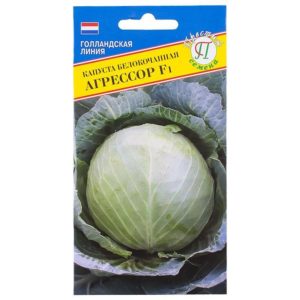
- 16 free amino acids (including tryptophan, lysine, methionine, tyrosine, histamine, etc.).
- Vitamins B, A, C, E, K, PP, as well as U, which has an antiulcer effect.
- The mineral composition is varied, including potassium, sulfur, calcium, phosphorus, magnesium, iron, cobalt, iodine, copper, zinc, manganese, etc.
Thanks to such a rich complex of chemicals, cabbage has many beneficial properties:
- Strengthens the immune system.
- Cleanses the body of toxins, cholesterol and other harmful substances.
- Prevents the development of atherosclerosis.
- Stabilizes blood sugar levels.
- Reduces the risk of developing pathologies of the heart and blood vessels.
- Improves liver and gall bladder functions.
- Reduces the risk of developing gout.
- Relieves joint pain.
- Prevents the development of benign and malignant neoplasms.
Features of application
The leaf pulp of the hybrid is juicy, crispy and very healthy, so it is often used to prepare fresh salads. It is added to first courses, stewed, fried, fermented, pickled. Cabbage Aggressor is suitable for pickling and preparation of other winter preparations, as it tolerates heat treatment well.
Ripening period
The ripening period for cabbage is medium-late, 120-130 days. Depending on the time of planting and weather conditions, the vegetable can reach full ripeness in mid-September - early October.
Productivity
The yield of the hybrid is stable and high - from 431 c/ha to 650 c/ha. The maximum figures were recorded in the Moscow region - 800 c/ha with a commercial product yield of up to 92-96%. Such figures are typical for industrial cultivation. Owners of private farmsteads manage to collect up to 10 kg from 1 sq. m.
Resistance to disease and cold
The vegetable has strong immunity.Thanks to the natural waxy coating on the leaf blades, the hybrid is highly resistant to thrips attacks. It is not susceptible to fusarium. However, if agrotechnical rules are not followed, the following may hurt:
- Kiloy. A fungal disease that cannot be treated. Develops on the root system in the form of growths. The leaf blades gradually lose color and fade.
- Downy mildew (downy mildew). A fungal infection appears as gray or yellow spots on the outside of the leaf and a whitish coating on the inside. Gradually the leaves die off and the plant dies.
Sometimes the crop is attacked by harmful insects: aphids, caterpillars, slugs and snails.

Cabbage tolerates periods of cold weather well, up to small frosts.
Characteristics of the appearance of leaves and heads of cabbage, taste
The rosette of the culture is large, raised above the ground. It is formed by small leaves of a gray-green color with a clearly visible waxy coating and wavy edges.
The fork of the hybrid has a dense structure, grows to medium size and a weight of 3-5 kg, sometimes under favorable conditions up to 6 kg. It has a round, slightly flattened shape. On the outside, the head of cabbage is colored greenish with a gray tint; when cut, it is bright white, sometimes with a slight yellowish tint. The length of the stalk is about 18 cm.
The dry matter content of the vegetable is 9.2%, and the total sugar content is 5.6%. Thanks to this, the taste of cabbage is high, the leaves are juicy and crispy.
In the photo - Aggressor F1 cabbage.

Suitable regions and climate requirements
Aggressor cabbage is grown in the Central region, Kuban, the Urals, and Siberia.The hybrid feels best in a temperate continental climate with not too cold winters and warm summers.
Advantages and disadvantages
According to reviews from gardeners, the hybrid has the following advantages:
- Excellently cultivated in areas with unfavorable climatic conditions and nitrogen deficiency. Gives 100% germination of seed.
- Non-seedling cultivation is possible.
- It has strong immunity to fusarium wilt, internal point necrosis, and is resistant to thrips.
- It is characterized by uniform ripening of heads of cabbage and high yields.
- It has an attractive appearance of forks that are not prone to cracking.
- Transports well.
- Universal to use.
Culture is not without its drawbacks:
- Has a relatively high cost of seeds.
- Susceptible to attacks by whiteflies and aphids.
- When salting yellowish heads of cabbage, a slight bitterness may appear.
Difference from other varieties and hybrids
Hybrid Aggressor F1 is distinguished by high growth vigor and is considered one of the most unpretentious crops:
- gives good yields on soils poor in organic matter;
- not afraid of drought;
- resistant to sudden weather changes;
- tolerates rainy seasons calmly (heads of cabbage do not crack).
Growing a persistent, unpretentious hybrid is the most successful option for beginning vegetable growers and those who cannot devote enough time to caring for cabbage plantings.
Features of planting and growing
This cabbage is grown both in seedlings and without seedlings. The planting option depends on the climatic conditions of the region in which it is planned to cultivate cabbage. In a region with a cold spring, the seedling method is chosen. This helps protect the plant from spring frosts.
Preparing for landing
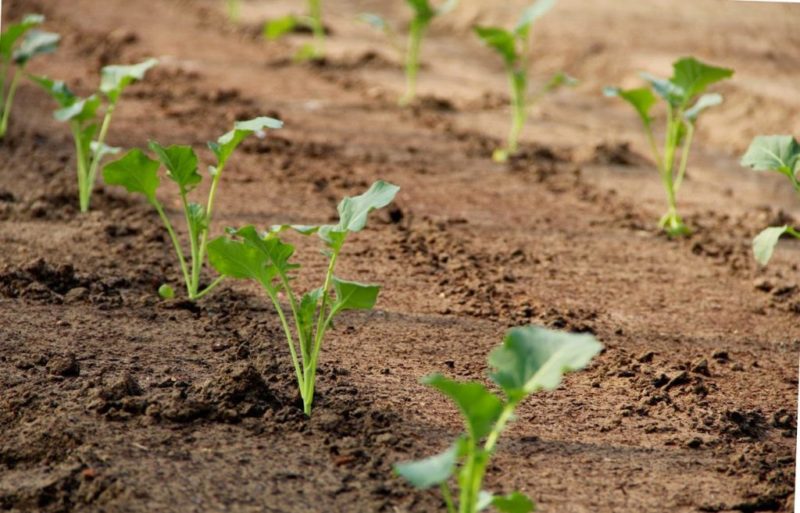
The planting process is preceded by a preparatory stage. It consists of several events.
Semyan
Seed material that has already been processed by the manufacturer is not soaked or processed. Rest seeds disinfected in a pink solution of potassium permanganate (2 g per 5 liters of water) for 4 hours. Some vegetable growers harden them. To make the seeds germinate faster, they are soaked in growth stimulants or germinated.
Seedlings
A specially prepared soil mixture consisting of garden soil and humus, taken in equal parts, is poured into small seedling boxes. Make furrows 1 cm deep, place seeds in them at a distance of 2 cm and lightly sprinkle with soil mixture.
Water with a spray bottle and cover with film. The containers are placed in a warm, dark place with a temperature of +22…+25°C. As soon as 4 true leaves are formed on the seedling, it is transplanted to a permanent place.
Non-seedling planting
The seedless method of growing cabbage involves sowing seeds directly into open ground.
Soil requirements
For higher yields, the soil composition must be fertile, with a low acid and alkali content (up to 4%). 3 weeks before planting, the beds must be fertilized: 5 kg of humus and 300 g of wood ash per 1 square meter. m.
Predecessors
Although the hybrid is not picky about soil, it is still worth observing crop rotation. The optimal beds are those where they were previously grown legumes, nightshade or pumpkin culture. It is not recommended to plant cabbage after cruciferous vegetables: radishes, horseradish, turnips, rutabaga, radishes.
Dates, scheme and rules of planting
Landing carried out from April 20 to May 1, when the air warms up to +20°C and there is no risk of return frosts.The bed is prepared in advance, preferably in a well-lit area.
Planting density and depth
The seeds are planted in moist soil according to a 50x50 cm pattern. 2-3 seeds are placed in each hole to a depth of no more than 1 cm.
Important! During planting, be sure to adhere to this pattern so that the bushes can freely develop both in height and width.
Features of cultivation
As soon as the first shoots appear, the cabbage is protected from direct sunlight and possible night frosts. Pegs are driven in around the perimeter of the bed and agrofibre or plastic film is stretched. When the seedlings grow up, the strongest ones are left, the rest are transplanted to another place or removed.
Nuances of care
Although the culture is unpretentious, it is still worth familiarizing yourself with the nuances of care.
Watering mode

Plantings require abundant and timely watering, otherwise moisture deficiency can lead to the death of young, thin, fibrous roots. For the first 2 weeks, cabbage is watered regularly once every 3-4 days in the morning and evening.I. For 1 sq. m is enough 6-8 liters of water.
Next, the number of waterings is reduced to once a week, and the volume of water is increased to 10-12 liters per 1 square meter. m. It is very important to adjust the regularity of watering depending on weather conditions. Watering is stopped 3-4 weeks before harvest.
Loosening and hilling
After watering and prolonged rains, the soil must be loosened, which ensures the penetration of air to the root system. The first time they are loosened to a depth of 4-5 cm, later - more deeply, to 8-10 cm. For better growth and the formation of adventitious roots, the plant is hilled up.
Top dressing
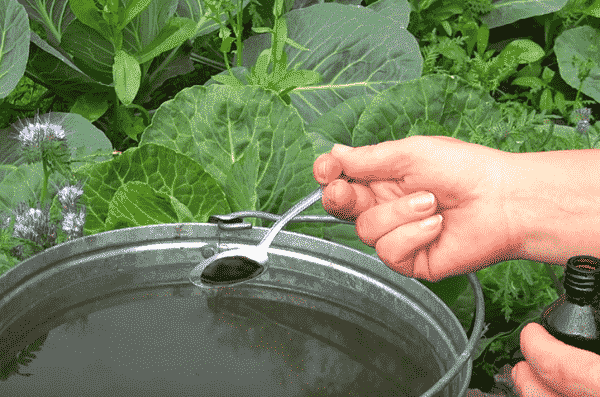
If the soil was sufficiently fertilized before planting the crop, fertilizing is not necessary. But in conditions of cultivation on heavy soils, additional application of fertilizers will not be superfluous:
- For the first time, cabbage is fed 3 weeks after planting. Take 10 g of saltpeter or urea per bucket of water. 200 ml of the prepared solution is poured under each bush.
- The second feeding is carried out before the formation of forks. To do this, dilute 10 g of potassium monophosphate in 10 liters of water and consume about 200 ml of solution per bush.
Measures to increase yield
To obtain abundant harvests of Aggressor F1 cabbage, it is important to adhere to the basic requirements for growing the crop:
- Follow the rules of crop rotation.
- Carry out activities to combat diseases and pests.
- Water regularly and fertilize in a timely manner.
Disease and pest control
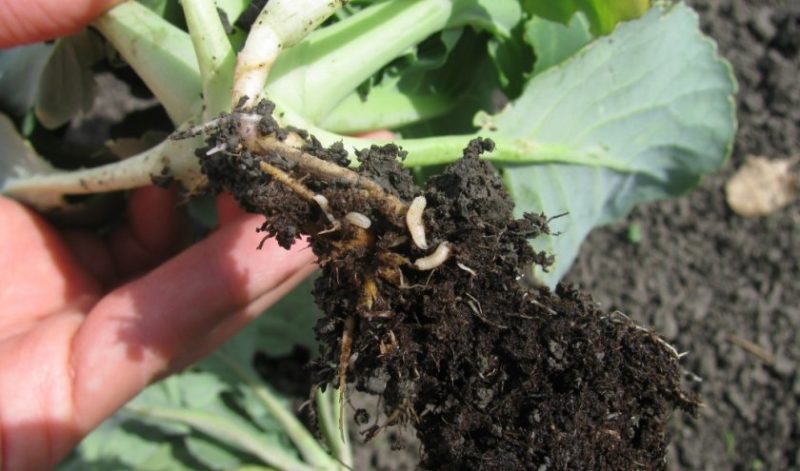
To combat fungal diseases and pests, the following measures are taken:
- Clubroot cannot be treated, so diseased bushes are immediately removed from the garden and the soil is disinfected. For prevention, when planting seedlings, the roots are dipped in a clay solution.
- When infected with peronosporosis, diseased bushes are destroyed, and the rest are sprayed with a 1% solution of Bordeaux mixture or copper sulfate. Fungicides "Tiram" or "Planriz" are also used.
- Aphids are fought with a solution of the drug “Oxychom” (30 g per 10 liters of water).
- For caterpillars, an infusion is prepared from tomato tops: 2 kg of raw material is poured into 10 liters of water and infused for 24 hours.
- A solution of colloidal salt (20 g per 10 liters of water) helps against slugs and snails.
Aromatic herbs are planted near the cabbage plantings: mint, marigolds, sage, rosemary to repel insects.
Harvest and storage
Cabbage ready for harvest is distinguished by the elasticity of its heads, its size and shiny leaves.They are cut off with a knife or an ax, leaving a stalk 3-4 cm long.
How and when to collect
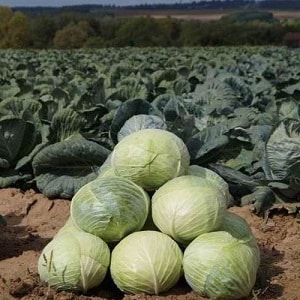
Since Aggressor cabbage has a medium-late ripening period, the collection of heads of cabbage begins in late September - early October. By this time they reach full maturity. Their clean up in dry weather at daytime temperatures not higher than +8°C.
Storage features and shelf life
Fully healthy heads of cabbage, without signs of damage or disease, are subject to long-term storage. They are placed in a basement or cellar in 2-3 rows or hung on slats by the stalks. The storage area must be ventilated.
Important! The optimal temperature for storing vegetables is +1…+5°C. The humidity in the room where plugs are stored must be at least 90%. You should avoid exposure to light, otherwise the cabbage will begin to sprout.
When optimal conditions are created, cabbage can be stored for up to 6 months without losing its quality.
Difficulties in growing
Cabbage hybrid Aggressor F1 sometimes suffers from aphid attacks and fungal diseases. This is the only thing that can complicate growing an unpretentious vegetable.
Tips and reviews from experienced gardeners
Gardeners growing Aggressor F1 note the high yield of the hybrid, good keeping quality of heads of cabbage and versatility of use.
Alexander, Kazan: “The cabbage hybrid Aggressor showed excellent results. It has a high yield; not a single head of cabbage was less than 3 kg. Aggressor F1 stores perfectly, especially when compared with other hybrids. If you keep the temperature within +3...+5°C, the heads of cabbage will lie quietly for at least six months, and nothing will happen to them.”
Semyon, Rostov-on-Don: “I have often heard that Aggressor F1 is very tough and hard, so summer residents do not want to grow it.But my family and I really liked this cabbage. Of course, the leaves are a little harsh, but you can cook anything from them. Cabbage is suitable for pickling, borscht, and cabbage rolls. The germination rate is high, and the Aggressor is stored until spring if you put it in the cellar.”
Conclusion
The white cabbage hybrid Aggressor F1, due to its high taste, attractive appearance, high immunity, and ease of care, is suitable for cultivation both in private farms and on an industrial scale. It is important to adhere to simple agrotechnical rules in order to obtain the highest yields of this vegetable crop.